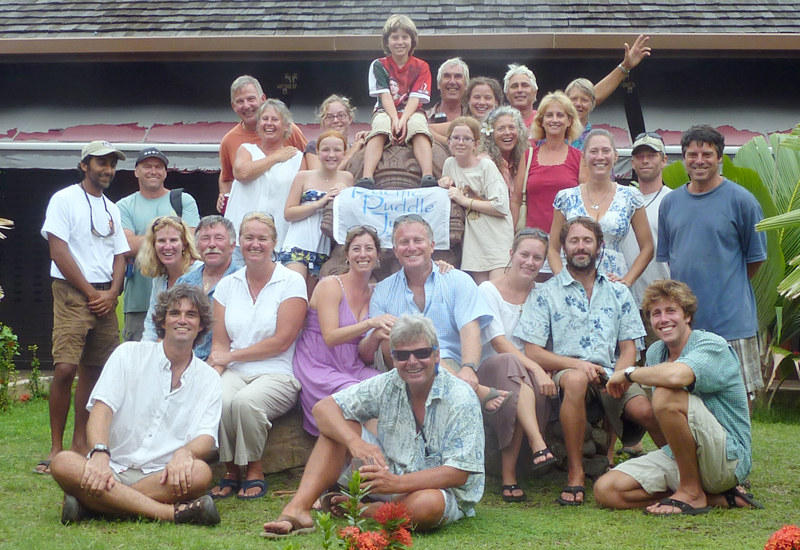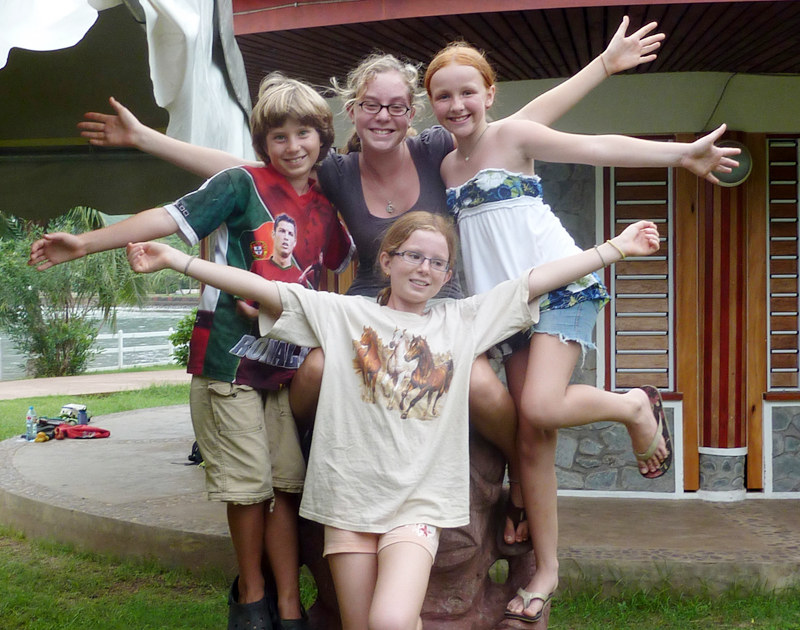
In Celebration of the Big Jump

©2011 Latitude 38 Media, LLC
Although the 3,000-mile passage from the West Coast of the Americas to French Polynesia can be a long, lonely trip, the trill of arriving beneath the towering peaks of the Marquesas Islands is a reward worth savoring.
"What a beautiful island!" write Carla and Doug Scott of the Albuquerque, New Mexico-based Tayana 42 Moondance. They recently made landfall at the northernmost port of entry, the Baie de Taiohae, on the island of Nuku Hiva. "There are several boats anchored here with us, so we decided to get together and celebrate our crossing, plus meet some of the other cruisers. For some of the Puddle Jumpers, this is their first landfall. Others arrived in Hiva Oa (to the south) and have been doing some island hopping."

© Latitude 38 Media, LLC
It seems pretty obvious by the photo above that the Puddle Jump kids were glad to make landfall, too. Naturally, both kids and adults all have "some amazing stories to tell," the best of which we hope to share with you in our upcoming Pacific Puddle Jump Recap article. After cruising the Marquesas and Tuamotus, many members of this year’s fleet will come together in Papeete in late June for the three-day Tahiti-Moorea Sailing Rendezvous (June 24-26). Stay tuned here for additional reports and check out the website for further Puddle Jump info.
Bill Garden Passes Away
Renowned yacht designer and naval architect William ‘Bill’ Garden passed away on April 29 near Sydney, B.C. He was 92.
A Canadian by birth, Garden lived in Seattle until the late ’60s, when he moved back to B.C. His designs were a tremendous influence on the industry and many have gone on to cruise the world successfully, though none have set any speed records. Some of the boats his pencil has been credited with drawing are the Mariner 36, Rawson 30, Formosa 51, and CT 41, among many others. Stout full-keel cruisers with a reputation for stability.
By all accounts, Garden was a generous and humble man who freely shared his knowledge and advice whenever asked. We know he’ll be sorely missed by those who knew him.
Wanted: Olson 30 Boom
Latitude 38 needs an Olson 30 boom in good condition ASAP. Contact Richard if you have one to spare.
Bar Pilots . . . or Bar Pirates?
"The pilots who steer the big ships in and out of the Bay have been green-lighted for a rate hike that could have them making upward of $432,000 a year by 2015," reported Phil Matier and Andrew Ross in the May 7 San Francisco Chronicle / S.F. Gate.
According to the journalists, "The new rates, which are paid by the 9,000 commercial ships that come into the Bay each year, were overwhelmingly approved by the State Board of Pilot Commissioners. The deal now goes to the legislature for its okay. There are 60 pilots working the Bay. On average, they each earned $393,207 last year. The year before, when business was up, they earned an average of $427,153."
"Nice work if you can get it," the duo editorialized. "But then, it’s a high-pressure job," they explained, "and the price of a single screw-up can be enormous — just ask John Cota, who ran the Cosco Busan container ship into the Bay Bridge in 2007."
A high pressure job? We don’t want to be disrespectful, particularly to a group of people who have to deal with the brain-dead antics of some recreational mariners, but could it be any more of a high-pressure job than being a brain surgeon, a cop in Oakland, or a clerk at a convenience store in a high-crime area? We always thought the highest pressure aspect of being a bar pilot was having to — no matter what the weather — climb up or down a Jacob’s Ladder to get from a pilot ship to a ship near the Lightbucket. Indeed, one pilot was lost not too many years ago during such an attempted transfer.
As for the matter of Cota’s "single screw-up," we think Matier and Ross sugar coated the hell out of it. On August 18 of last year, the staff at the San Francisco Examiner wrote an interesting report on it:
"Veteran mariner John Cota is due to finish a 10-month federal prison sentence today, which he served for environmental misdemeanors after piloting the Cosco Busan container ship into a Bay Bridge tower on November 7, 2007. The accident tore open fuel tanks, leading to a 53,500-gallon spill that killed birds and seals, closed beaches, suspended fishing and devastated bait-fish populations, wreaking havoc on the ecosystem. National Transportation Safety Board investigators identified many causes of the crash, including insufficient crew training by the ship operator, the crew’s unwillingness to challenge Cota’s decisions, the Coast Guard’s failure to warn Cota that he was off course, and Cota’s decision to sail in fog.
"Investigators blamed Cota’s use of prescription drugs, including Vicodin and Valium or generic equivalents, as a cause of the accident." Cota was not tested for pharmaceuticals after the accident, and in court he denied being affected by them. For the record, drugs such as Valium come with the caution: "Use care when operating machinery."
According to the Examiner article, "The pilot used a chart to navigate through the Bay after telling the ship’s master that he couldn’t use the radar, which investigators said was working. Cota misinterpreted triangles on the chart, which represented a bridge tower, and sailed toward them. He avoided a head-on crash after a lookout spotted the tower."
Somebody gets paid over $400,000 a year to guide ships in and out of the Bay and "misinterpreted triangles on the chart, which represented a bridge tower, and sailed toward them." What next, air traffic controllers sleeping on the job?
As far as we’re concerned, the two most disturbing aspects of this story are: 1) The bar pilots still aren’t tested for the use of pharmaceutical drugs that might render them senseless. It’s just a wild guess, but we bet this is part of their union contract. And 2) that the State Board of Bar Pilots would "overwhelming approve" such an increase in pay in these hard economic times, particularly without insisting that pilots be tested for dibilitating pharmaceutical drug use.
Our question to you is this: Do you think the State Board of Bar Pilots is more interested in the welfare of bar pilots or of the general public and the environment and the safety of our basic infrastructure? Send your comments to Richard.
